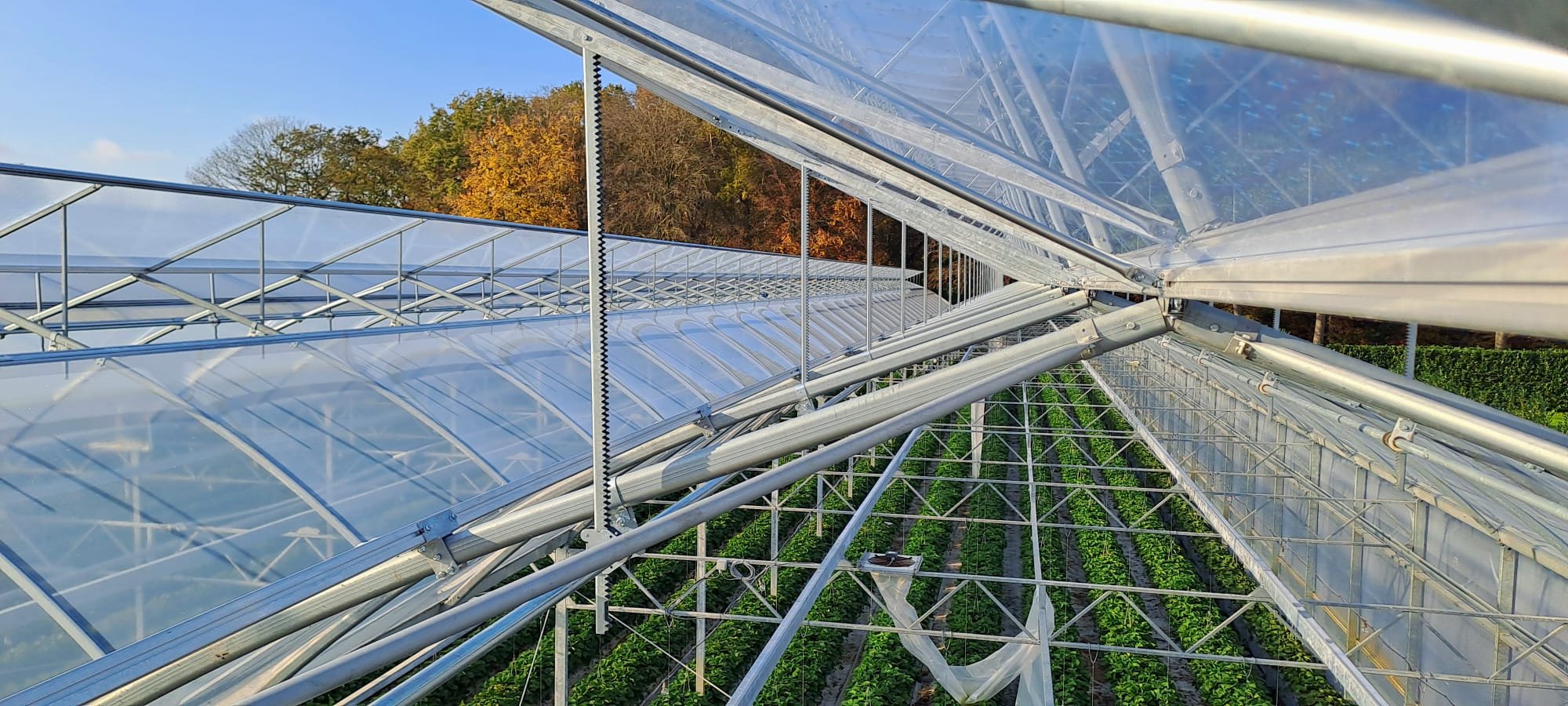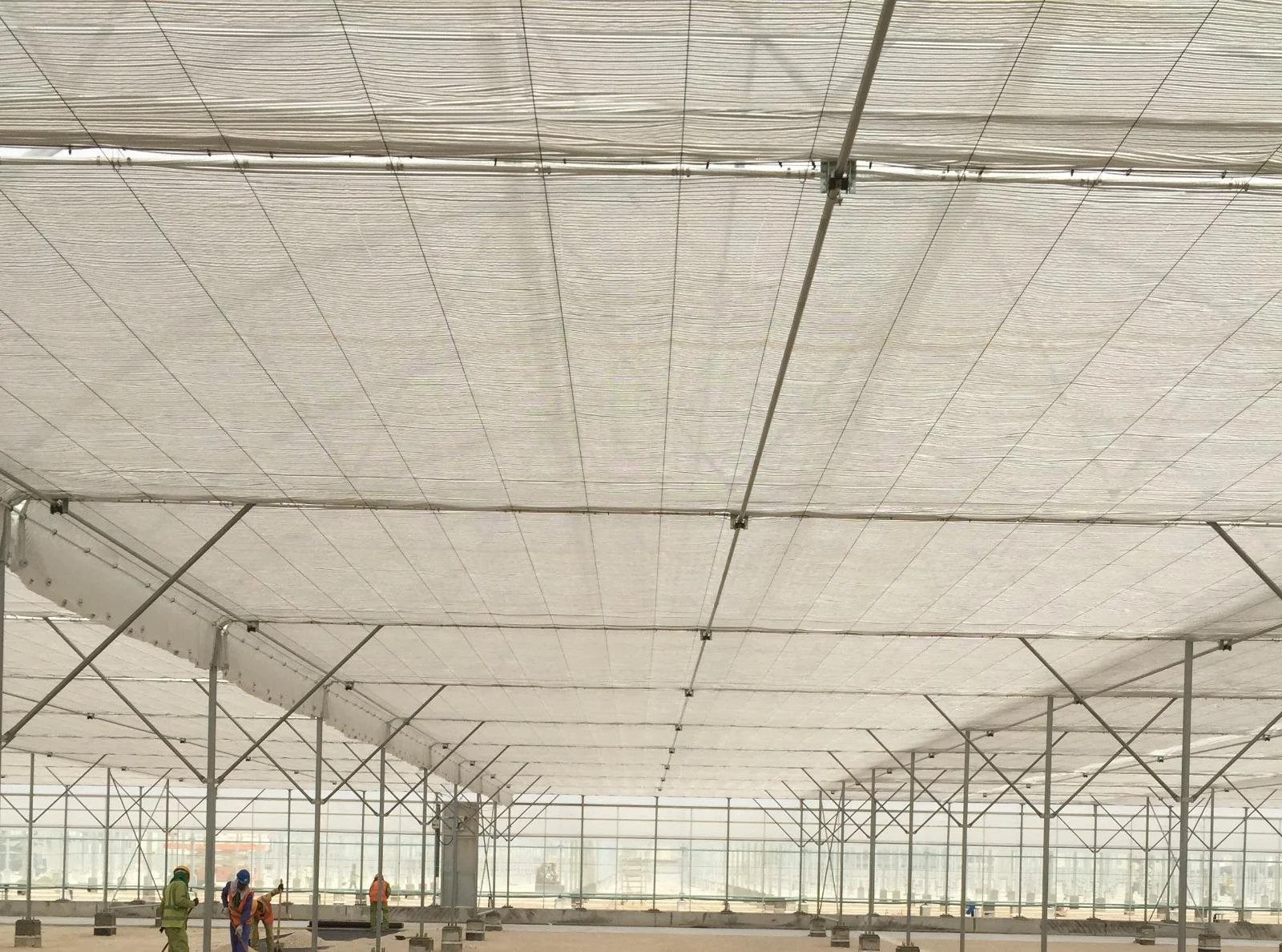The Economic Renaissance of Smart Polyfilm Greenhouses: A Sustainable Path to Agricultural Profitability
Auteur: Jacco van Delden
Growing up in the greenhouse industry, I remember when plastic “polyfilm” greenhouses were often seen as the budget alternative. Useful, yes, but hardly the star of the show. How times have changed. Today, we are witnessing an economic renaissance of smart polyfilmgreenhouses, where affordability, innovation, and sustainability converge to transform agriculture. In this piece, I’ll share my perspective on how modern polyfilm greenhouses are driving profitability for growers in the U.S. and across hot, arid regions like Qatar, Saudi Arabia, and the UAE, all while championing sustainable practices.
A New Era for Polyfilm Greenhouses
Not long ago, if you wanted a high performance greenhouse, you likely invested in glass or rigid polycarbonate. Polyethylene film greenhouses, by contrast, were valued mainly for their low cost and ease of setup. But thanks to leaps in technology, polyfilm structures have shed their “cheap and flimsy” reputation. In fact, polyethylene film is now the most common greenhouse covering worldwide due to its low cost, availability in large sheets, ease of attachment, and excellent light transmission. This cost-effectiveness means growers can build controlled environments with significantly lower initial investment than traditional glasshouses. As one industry expert noted, “the most cost effective structure covering is the long life greenhouse film. Your initial outlay is significantly less and you have more flexible options” (Greenhouse Film Basics Greenhouse Product News). In practical terms, a polyfilm greenhouse can often be constructed for a fraction of the cost of an equivalent glass structure, yet it still provides the essential protection and climate control that drive higher yields.
Equally important, these greenhouses deliver results. The high yields and quality achieved in controlled environments are a primary reason growers are turning to greenhouses in the first place. For example, the adoption of greenhouses in Qatar is largely driven by their ability to provide much greater crop production compared to open field farming (Qatar Greenhouse Market Set to Reach $309.2 Million by 2027 - ResearchAndMarkets.com). By shielding crops from pests and weather extremes, and by optimizing light and humidity, even a simple plastic-covered structure can dramatically outperform traditional methods in productivity. And with modern designs, polyfilm greenhouses are not just seasonal structures; they support year round cultivation, offering growers a way to produce consistent, off season harvests that command premium prices. This combination of low cost and high output has made polyfilmgreenhouses a compelling choice for profitability in diverse markets.
Smart Design, Durability, and Innovation
One of the biggest misconceptions about polyfilm greenhouses is that they’re short lived or unsophisticated. While it’s true that early polyethylene films in the 1960s had to be replaced every year due to UV and weather degradation, those days are long gone. Today’s long life greenhouse films are typically multi layered, UV stabilized, and warranted to last about five years or more in harsh sun. That durability, combined with the low replacement cost of film, actually becomes an advantage; growers can afford to re-cover their greenhouses every few years and continually upgrade to the latest film technologies (such as new light diffusing or infrared-blocking films) as they emerge. Modern polyethylene covers can even include anti drip and anti-dust coatings to maintain high light transmission and crop health over their lifespan. In windy locations or extreme conditions, stronger woven or reinforced films are available to ensure the greenhouse skin holds up. The bottom line is that polyfilm houses are no longer “disposable” at all, they’re built to last and protect.
“Smart” polyfilm greenhouses also embrace cutting edge design features. For instance, ventilation and climate control in these structures have seen tremendous improvements. High-end polyfilm greenhouses can be outfitted with automated ridge vents, roll up side walls, evaporative cooling pads, and even full climate computers, just like their glass counterparts. In fact, the integration of smart greenhouse technology like IoT sensors, AI-driven climate controls, remote monitoring etc. is happening across the industry, including in polyfilm houses. In recent years, growers worldwide have rapidly adopted these innovations, allowing them to finely monitor and adjust temperature, humidity, and light with precision from a smartphone or control room (MEA Commercial Greenhouse Market Size Report | 2024 To 2032). The result is a fully optimized microclimate for plants. Even in a simple plastic tunnel, one can maintain ideal growing conditions through intelligent controls, maximizing growth while minimizing resource use.
Ingenious engineering has also made polyfilm greenhouses faster and safer to build and maintain. As an example from our company’s experience, we developed a model called the HortiHouse that introduces a patented method to attach the poly film from inside the greenhouse frame. This means an entire greenhouse can be covered in one go without workers climbing onto the roof, vastly improving safety and speed. In our trials, a crew with a lift can unroll and secure the film across a widespan structure in a single day, a task that used to be weather dependent and labor intensive. Features like this exemplify how smart design tweaks are reinventing what a “plastic greenhouse” can do. Similarly, many polyfilm greenhouses now use double layer inflatable roofs (two layers of film with air blown between them) for better insulation and stability. It’s clear that innovation in polyfilm structures has extended their lifespan, strength, and capabilities, turning them into sophisticated growing environments rather than just cheap shelters.
Innovations like Rovero’s HortiHouse allow polyfilm covers to be installed safely from ground level, reducing construction time and risk. Modern designs also include automated vents and climate controls, making polyfilm greenhouses as high tech as needed.
Thriving in Hot and Arid Climates
Perhaps nowhere is the impact of this greenhouse renaissance more evident than in the hot, arid climates of the Gulf region. Traditional open field farming in deserts is a herculean challenge with extreme heat, intense sun, scarce water, and sandstorms are formidable obstacles. Yet polyfilm greenhouses, when equipped with the right technology, are proving they can not only survive but thrive in these conditions, unlocking local food production in places once deemed inhospitable to agriculture.
A key to their success is the ability of polyfilm structures to create a cool, controlled oasis in the middle of a desert. Techniques like using a double layer poly film cover (often with one layer being a diffusive or IR-reflective film) provide extra insulation against the blistering. This double covering, combined with modern cooling systems, has shown to be highly effective in maintaining optimal growing conditions even in extreme climates. For example, advanced greenhouses in the Middle East pair pad and fan evaporative cooling with reflective shade screens under the roof. As hot outside air is drawn through watersoaked pads, the interior temperature drops dramatically, while the dual-layer roof slows heat gain. Crops that once struggled in 45 °C summers are now flourishing in such greenhouses, an outcome that seemed like magic just a decade ago (How greenhouses are cooling in the Middle East). One report by a leading greenhouse builder noted that with robust cooling and a double poly cover, their client’s vegetables were successfully grown through peak summer, demonstrating that technology can indeed beat the heat.
In addition to cooling, water conservation is a decisive factor for Gulf growers. Here, controlled-environment greenhouses have a massive edge over open fields. By recycling irrigation water (for instance, using hydroponics or drip systems with runoff capture), greenhouse cultivation can slash water usage by up to 90% compared to traditional farming. This efficiency is life-saving in water-scarce regions. To put it in perspective: studies have found that producing a kilogram of tomatoes in a greenhouse can use only a fraction of the water needed in an open field, yet yield far more produce (What is Greenhouse Farming? | History, Types, and Benefits). Polyfilm greenhouses make such water saving techniques accessible at scale, because they are affordable enough to deploy widely and can be set up with the necessary plumbing for recirculation. For Middle Eastern countries that rank among the world’s most water-stressed, the marriage of low cost greenhouse structures and high efficiency irrigation is enabling a leap toward sustainable food security.
Moreover, polyethylene film itself handles the harsh UV and dust of desert environments surprisingly well. Saudi Arabia, for instance, has increasingly turned to polyethylene covers for its greenhouses because they’ve proven tough enough to endure the Saudi climate, often outperforming more expensive covering materials (Assessing the Effectiveness of Reflective and Diffusive Polyethylene Films as Greenhouse Covers in Arid Environments). This is a strong vote of confidence in polyfilm’s suitability for extreme conditions. When the plastic does eventually need replacing after its lifespan, it’s a relatively quick and inexpensive process, critical for operations in remote or challenging areas. Some greenhouse projects are even experimenting with special additives (like UV blockers and anti-dust coatings) in the film to further extend its life under desert sun and sand. The ability to fine-tune the film properties to the climate is another advantage that glass simply cannot offer. In short, modern polyfilm greenhouses have become resilient workhorses for hot climates, delivering reliable production where traditional farming or older greenhouse systems would quickly fail.
Proven Results in the Middle East
The success of polyfilm greenhouses isn’t just theoretical, it’s playing out on the ground across the Middle East. In Qatar, for example, a cluster of greenhouses totaling 6 hectares has been operational in the desert outside Doha since 2020 (6ha film-PC greenhouses under operation in the desert of Qatar). These greenhouses use plastic film roofing over their spans (with insulated panels on the sidewalls) and are equipped with shade cloth and fan-and-pad cooling. The project was designed explicitly to cope with Qatar’s high temperatures and sandstorms, and it achieved that goal: the greenhouses are reliably supplying fresh tomatoes to the local market. Notably, the engineers chose a single layer polyfilm roof because it kept construction costs lower than a glasshouse would have, yet still “ensured a proper growing climate inside” the structures. The fact that such a large, film based greenhouse development is thriving in Qatar’s desert is a powerful proof of concept. It shows that with smart engineering, polyfilm greenhouses can deliver commercial scale production and withstand regional challenges, all while offering a faster return on investment for growers (thanks to that lower upfront cost).
Saudi Arabia has also embraced polyfilm greenhouse technology as a pillar of its food security strategy. The Kingdom’s National Food Production Initiative (NFPI), part of its broader Vision 2030, has invested heavily in greenhouse farming, including state of the art polyfilm structures. In 2024, a collaboration between SABIC and local partners unveiled a high tech, durable polyethylene greenhouse roofing film made from advanced recyclable plastic, which was implemented on a one hectare model farm in Riyadh. This widespan greenhouse, using the innovative film, has been operational and yielding successfully, validating the approach and even contributing to circular economy goals (since the film is made from recycled material. The NFPI model farm underscores how public private initiatives are leveraging polyfilm greenhouses for sustainable farming in Saudi Arabia. By using plastic covers, the project kept costs reasonable, allowing more hectares to be built for the budget. And importantly, the specially engineered film delivered on durability, a critical factor under the intense sun of Riyadh. Such successes are encouraging further expansion: the Saudi government continues to fund greenhouse projects, recognizing that controlled environment agriculture is key to reducing dependence on imported food (MEA Commercial Greenhouse Market Size Report | 2024 To 2032)
Across the region, momentum is building. The UAE is spearheading hightech greenhouse projects to meet local demand for fresh produce and cut down on imports. Many of these projects utilize polyfilm structures, from simple cooled hoop houses used by local farmers to ultra-modern commercial farms growing lettuce and berries outside Abu Dhabi. Government incentives and partnerships have spurred growers to invest in these systems despite the learning curve. The payoffs are already visible, for instance, the Emirates are now able to grow significant quantities of cucumbers, tomatoes, and leafy greens domestically in greenhouses, something that was impractical at scale decades ago. According to market research, the Middle East and Africa greenhouse market (which includes many polyfilminstallations) is on a sharp growth trajectory, expected to more than double in value over the next decade as countries ramp up protected agriculture (Qatar Greenhouse Market Set to Reach $309.2 Million by 2027 - ResearchAndMarkets.com) In Qatar alone, the greenhouse sector value jumped from around $125–137 million in 2020-2021 to a projected $309 million by 2027 (Qatar Greenhouse Market Set to Reach $309.2 Million by 2027 - ResearchAndMarkets.com), a CAGR of over 14%, driven by the success of greenhouse farming in boosting local production. These numbers signal a validation of polyfilmgreenhouse efficacy: growers wouldn’t be scaling up if the profits and results weren’t real.
What’s especially heartening is hearing the feedback from growers in these Gulf regions. Many of them are first time greenhouse users, and their initial skepticism about “plastic houses” turns into amazement when they see the harvests. I’ve spoken with farmers who, after installing affordable poly tunnels and learning to manage the climate controls, achieved yields of vegetables that were unthinkable in open fields, all while using a fraction of the water. By empowering growers in Qatar, Saudi Arabia, the UAE and beyond to produce food sustainably and profitably at home, polyfilm greenhouses are not just an economic tool; they’re becoming a cornerstone of food security and agricultural self-sufficiency in the Middle East.
Sustainability and Profitability in Harmony
At the end of the day, the renaissance of polyfilm greenhouses comes down to a beautifully simple proposition: they make farming both more profitable and more sustainable. On the profitability side, we’ve seen how lower construction costs, higher yield potential, and year round production can improve a grower’s bottom line. A plastic greenhouse typically pays for itself much faster than a glass greenhouse, allowing even small scale farmers or entrepreneurs in emerging markets to enter the protected agriculture arena. Maintenance is relatively straightforward, and expanding or modifying the structure is easier, you can extend a polyfilm range bay by bay as your business grows. Additionally, the flexibility of the film covering means growers can adapt to market changes; for example, switching to a different film type to better suit a new crop or climate condition is feasible and not cost-prohibitive.
On the sustainability side, polyfilm greenhouses align perfectly with the global push for resource-efficient farming. They help conserve land (by enabling vertical growing and higher yields per square foot), save water (through recirculation and reduced evaporation, as discussed), and often require fewer chemical inputs (since the enclosed space is easier to manage for pests and diseases, reducing pesticide use). Environmentally, the carbon footprint of constructing a polyfilm greenhouse is lower than that of a glass one, manufacturing and transporting a lightweight plastic cover simply consumes less energy than producing heavy glass panels or metal cladding. And every pound of produce grown locally in a greenhouse is one less pound that might be airfreighted from abroad, meaning less transportation-related emissions. In regions like the Gulf, where food is frequently imported over long distances, this shift to local greenhouse production has meaningful climate benefits.
Crucially, the economic and environmental benefits reinforce each other. Using less water and energy not only is good for the planet, but it also lowers operating costs. Raising healthy crops with fewer pesticides not only protects ecosystems, but also creates premium quality produce that can fetch higher prices in health conscious markets. These synergies are turning polyfilm greenhouses into a model of sustainable profitability, proof that “green” solutions can make great business sense. As a grower or investor, you’re no longer forced to choose between profit and planet; with the right greenhouse approach, you achieve both.
Conclusion: Embracing the Polyfilm Revolution
In reflecting on this transformation, I can’t help but feel optimistic about the future of agriculture. What started as humble polyethylene sheets stretched over frames has evolved into a sophisticated, smart enabled, global phenomenon that is reshaping how we grow food. From the heartland of America to the Arabian deserts, polyfilm greenhouses are empowering growers to do more with less, more crop output with less cost, less land, less water, and less risk. This is truly an economic renaissance, one that puts sustainable farming within reach for countless growers.
For growers in the U.S. considering an investment in greenhouse production, or growers in Qatar, Saudi Arabia, and the UAE looking to expand your operations, the message is clear: don’t underestimate the power of polyfilm. These greenhouses have proven their worth in some of the toughest environments on Earth, and they’ve leveled the playing field in controlled agriculture. A well designed polyfilm greenhouse can be your sustainable path to profitability, allowing you to stay competitive and resilient in a changing climate and market.
As a company who is dedicated to support farmers, we encourage embracing this technology with both hands. The renaissance is here and now. By marrying practical economics with innovative sustainability, smart polyfilm greenhouses are not just a trend, they are a foundation for the future of agriculture. Let’s continue to pioneer, adapt, and share these solutions so that growers everywhere can prosper, and so that we can feed our communities in a way that is responsible, enduring, and abundantly fruitful. The greenhouse revolution is growing strong, and it’s an exciting time to be part of it.
— Jacco van Delden (Managing Director, Rovero Systems)




